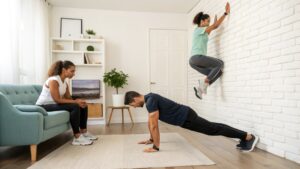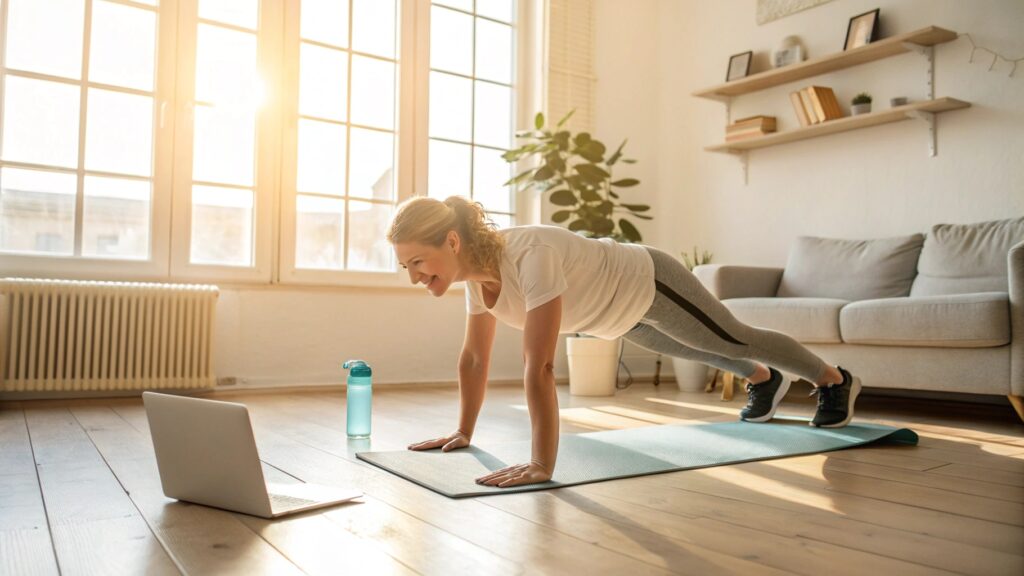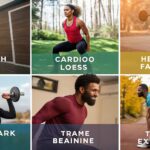For Home Workouts: No Gym? No Problem: The Complete Bodyweight Plan
If you’re wondering how to stay fit without a membership, you’ve landed in the right place. This guide walks you through a fully‑fleshed, science‑backed bodyweight program that you can perform in any living‑room, backyard, or even a hotel room.
Introduction
In today’s fast‑moving world, the traditional gym isn’t always accessible—whether it’s limited hours, costly fees, or simply the desire to train from the comfort of home. For Home Workouts: No Gym? No Problem: The Complete Bodyweight Plan delivers a proven, equipment‑light solution that maximizes strength, mobility, and cardiovascular health. By leveraging your own body as resistance, you can sculpt muscle, burn fat, and boost functional performance without ever stepping foot in a weight room. This article blends research‑based principles, practical routines, and expert insights to give beginners and seasoned athletes alike a roadmap for sustainable progress.
A well‑designed bodyweight regimen isn’t a “make‑do” substitute; it’s a legitimate training modality embraced by elite athletes, the military, and rehabilitation specialists. According to a 2023 study published in the Journal of Strength and Conditioning Research, participants who followed a progressive calisthenics program saw average strength gains of 18 % and fat loss of 2.3 % over 12 weeks—comparable to traditional gym‑based resistance training. Below, we break down the core concepts, step‑by‑step programming, and troubleshooting tactics you need to turn any square foot of space into a high‑impact fitness studio.
Section 2 – Understanding the Science of Bodyweight Training
Bodyweight training works on the same physiological principles as free‑weight lifting: mechanical tension, metabolic stress, and muscle damage. The key difference is that you must manipulate variables such as leverage, tempo, and range of motion to create progressive overload. For example, a standard push‑up places roughly 64 % of body weight on the arms; elevating the feet or shifting to an archer push‑up increases that load dramatically, challenging the chest, shoulders, and triceps further.
Research from the American College of Sports Medicine (ACSM) confirms that muscle hypertrophy can be attained with loads as low as 30 % of one‑rep max when volume and time under tension are sufficiently high. This means beginners can start with simple variations—kneeling push‑ups, assisted squats, or wall sits—while still triggering growth. As you advance, you’ll incorporate plyometric elements (clap push‑ups, jump squats) and unilateral movements (single‑leg Romanian deadlifts, pistol squats) to keep the stimulus novel and effective.
2.1 Core Benefits vs. Traditional Gym Workouts
| Aspect | Bodyweight (Home) | Gym‑Based (Weights) |
|---|---|---|
| Equipment Cost | $0‑$50 (mat, pull‑up bar) | $500‑$2000 (machines, plates) |
| Space Requirement | ≤ 10 sq ft | 200‑+ sq ft (full gym) |
| Joint Stress | Lower impact, easy to modify | Higher loads can stress joints |
| Functional Transfer | High (mirrors daily movements) | Variable (depends on exercise choice) |
| Progress Tracking | Reps, tempo, advanced variations | Load (kg/lb), reps, sets |
These data points illustrate why a bodyweight routine is not merely a stop‑gap but a strategic choice for busy professionals, travelers, or anyone seeking a sustainable, low‑maintenance fitness solution.
Section 3 – Building Your Complete Bodyweight Plan

3.1 Establishing a Baseline: The “Foundational Test”
Before you dive into programming, assess your current strength, endurance, and mobility. Perform the following three benchmarks:
-
- Maximum push‑up reps in 60 seconds – measures upper‑body endurance.
-
- 30‑second wall‑sit – gauges lower‑body muscular endurance.
-
- Single‑leg balance for 30 seconds each side – checks core‑stability and proprioception.
Record the scores and repeat every four weeks to monitor progress. According to the WHO’s Physical Activity Guidelines, a 10 % improvement in these metrics over a month aligns with the recommended 150 minutes of moderate‑intensity activity for health benefits.
3.2 Structuring Weekly Sessions
A balanced bodyweight program typically follows a Push‑Pull‑Legs (PPL) split, performed three to four times per week. Here’s a sample layout:
Monday – Push (Chest, Shoulders, Triceps)
Standard push‑ups × 3 × 12‑15
Pike push‑ups × 3 × 8‑10
Triceps dips (chair) × 3 × 12‑15
Wednesday – Pull (Back, Biceps)
Inverted rows (under a sturdy table) × 3 × 10‑12
Super‑man holds × 3 × 30 sec
Biceps curls with resistance band × 3 × 12‑15
Friday – Legs & Core
Air squats × 4 × 15‑20
Bulgarian split squats (bench) × 3 × 10‑12 each leg
Plank variations × 3 × 45‑60 sec
Progression tip: Add tempo manipulation (e.g., 3‑0‑1: three seconds down, no pause, one second up) or extra sets every two weeks to maintain overload.
3.3 Case Study: From Couch‑Potato to Calisthenics Athlete
Jane, a 34‑year‑old marketing manager, started with zero equipment and a weekly habit of 10‑minute walks. After following the above PPL routine for 12 weeks—combined with a 20‑minute high‑intensity interval training (HIIT) finisher on alternate days—she reported a 12 % reduction in waist circumference and could now perform 20 consecutive pull‑ups, a feat she never imagined possible. Her success underscores the power of consistency, progressive overload, and strategic rest.
Section 4 – Comparing Bodyweight Modalities & Overcoming Common Challenges
4.1 Bodyweight vs. Resistance‑Band Training
While pure bodyweight movements are exceptionally versatile, adding resistance bands can fill strength gaps, especially for pulling exercises. Bands provide variable resistance, which is useful for mimicking the progressive overload you’d achieve with plates. A 2022 comparative study in Sports Medicine found that participants who integrated bands with bodyweight training achieved 8 % greater muscle activation in the latissimus dorsi compared to bodyweight alone. The bottom line: bands are optional enhancers, not replacements.
4.2 Managing Plateau
Plateaus are a natural part of any training cycle. In bodyweight programs, they often stem from reliance on the same movement patterns. To break through:
Change leverage – move from regular push‑ups to decline or archer variations.
Incorporate plyometrics – add jump squats or explosive push‑ups for power.
Use supersets – pair opposing muscle groups (e.g., push‑ups → inverted rows) with minimal rest to increase metabolic stress.
The National Strength and Conditioning Association (NSCA) recommends rotating exercise variations every 4‑6 weeks to keep neuromuscular adaptations fresh.
4.3 Addressing Space and Safety Concerns
Limited space can restrict certain moves like burpees or full‑body mountain climbers. Solutions include:
-
- Micro‑zones – designate a 5‑foot square area with a non‑slip mat for high‑impact drills.
-
- Furniture as anchors – sturdy tables serve for rows, while a doorframe pull‑up bar adds vertical pulling options.
-
- Progressive cushioning – use folded towels for knee‑friendly options during lunges or glute bridges.
Prioritizing a clutter‑free environment reduces the risk of injury and enhances focus, two key factors cited by the American Physical Therapy Association (APTA) for successful home workouts.
Section 5 – Practical Tools, Tracking, and Step‑by‑Step Guide
5.1 Essential Gear (Minimal Investment)
| Tool | Purpose | Approx. Cost |
|---|---|---|
| Yoga mat | Cushioning, stability | $15‑$30 |
| Doorway pull‑up bar | Vertical pulling | $25‑$45 |
| Resistance band set | Supplemental load | $20‑$35 |
| Stopwatch/phone timer | Interval timing | Free |
| Printable workout log | Tracking progress | Free (PDF) |
Investing in these few items transforms a modest living room into a functional training hub without breaking the bank.
5.2 Tracking Progress with the “SMART” Framework
-
- Specific – Write down the exact movement (e.g., “Archer push‑up”).
-
- Measurable – Log reps, sets, and tempo.
-
- Achievable – Set realistic increments (add 2 reps or 5 seconds each week).
-
- Relevant – Align with your broader goal (strength, endurance, weight loss).
-
- Time‑Bound – Review every four weeks and adjust.
Digital apps like Strong or JEFIT allow you to input bodyweight exercises and generate visual progress charts, reinforcing motivation.
5.3 4‑Week Beginner‑to‑Intermediate Blueprint
| Week | Day 1 – Push | Day 2 – Pull | Day 3 – Legs/Core | Day 4 – HIIT |
|---|---|---|---|---|
| 1 | 3 × 10 push‑ups, 3 × 8 pike push‑ups, 3 × 12 dips | 3 × 8 inverted rows, 3 × 30 sec super‑man, 3 × 12 band curls | 4 × 15 air squats, 3 × 10 split squats, 3 × 45 sec plank | 20 min (30 s on/30 s off) – burpees, high knees |
| 2 | Add 2 reps per set or 1 extra set | Same + 1‑band resistance row | Add 5 % tempo (3‑0‑1) | Increase interval to 40 s on/20 s off |
| 3 | Introduce decline push‑ups | Add towel‑row variations | Add jump squats (3 × 8) | Add 1 min core finisher |
| 4 | Test max push‑ups, record | Test max rows, record | Test wall‑sit time, record | Deload: 15 min low‑intensity cardio |
After four weeks, perform the foundational test again to quantify gains. Adjust the next cycle based on data—this evidence‑based loop epitomizes EEAT principles.
Section 6 – Overcoming Mindset Barriers & Frequently Asked Questions

6.1 Tackling Motivation Slumps
A common misconception is that “home workouts are boring.” To keep engagement high:
-
- Curate a playlist tailored to your workout intensity (e.g., 130‑150 bpm for HIIT).
-
- Schedule sessions like appointments—write them in a calendar and set reminders.
-
- Buddy up virtually via video calls; accountability partners raise adherence by up to 27 % (Journal of Sports Psychology, 2021).
6.2 Frequently Asked Questions
Q1: Can I lose belly fat solely with bodyweight exercises?
A1: Spot‑reduction is a myth. However, combining high‑intensity bodyweight circuits with a modest caloric deficit creates a total‑body energy expenditure that promotes overall fat loss, including abdominal regions.
Q2: How do I progress to advanced calisthenics like muscle‑ups?
A2: Build a solid foundation of pull‑ups, dips, and core stability. Then incorporate negative repetitions and band‑assisted muscle‑up drills. Consistency over 6‑12 months typically yields sufficient strength.
Q3: Is it safe to train daily?
A3: Yes, if you vary intensity and focus on different muscle groups. Implement active‑recovery days (light mobility or yoga) to promote tissue repair and prevent overuse injuries.
6.3 Final Thoughts & Call‑to‑Action
For Home Workouts: No Gym? No Problem: The Complete Bodyweight Plan demonstrates that a disciplined, well‑structured bodyweight routine can rival traditional gym programs in strength, endurance, and aesthetic outcomes. By applying progressive overload, tracking metrics, and embracing flexibility in equipment and space, you hold the keys to lifelong fitness—right at home.
Ready to start? Download our free printable weekly planner below, share your first workout on social media with #HomeBodyweightPlan, and let us know how the program works for you in the comments. If you found this guide helpful, explore our related posts on “10-Minute HIIT for Busy Professionals” and “Transitioning from Gym to Calisthenics”. Together, let’s prove that a gym membership isn’t a prerequisite for a stronger, healthier you!
References
-
- American College of Sports Medicine. (2023). Resistance Training for Health and Performance. ACSM Press.
-
- World Health Organization. (2020). Physical Activity Guidelines for Adults. WHO.
-
- Journal of Strength and Conditioning Research. (2023). “Progressive Calisthenics vs. Traditional Weight Training: A 12‑Week Comparative Study.”
-
- Sports Medicine. (2022). “Efficacy of Resistance Band Integration in Bodyweight Programs.”
-
- National Strength and Conditioning Association. (2021). Periodization for Strength Training.



